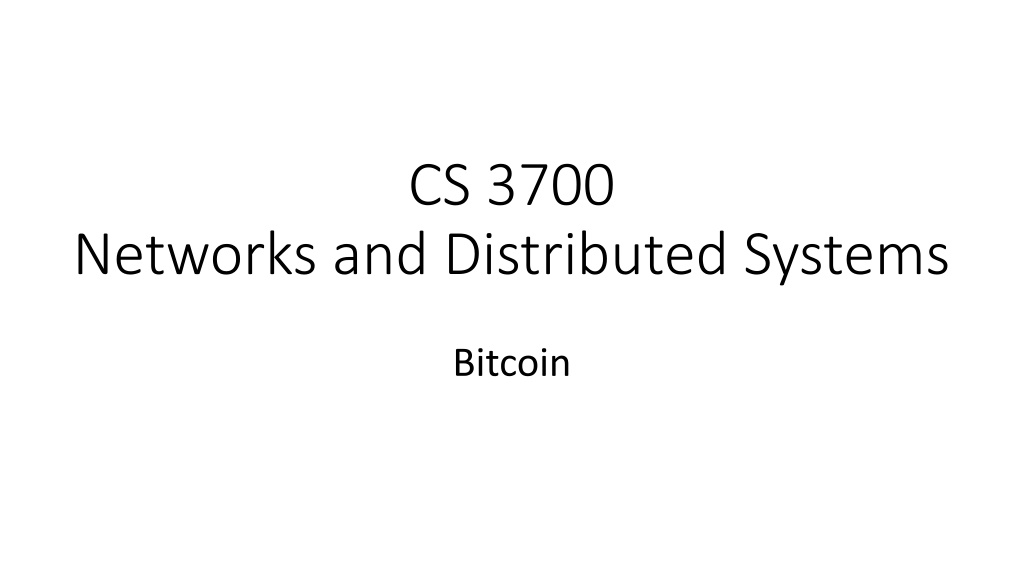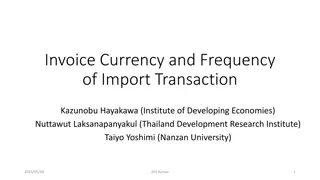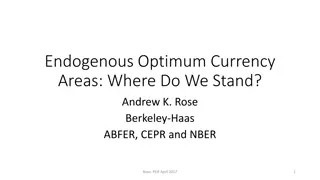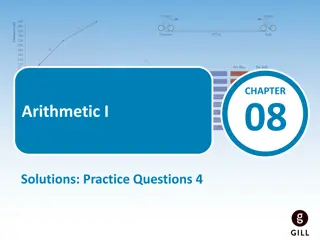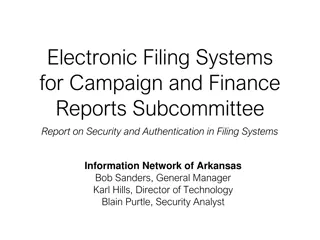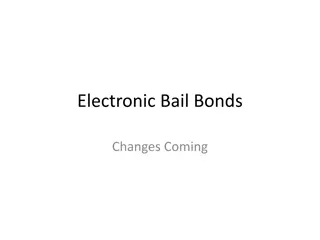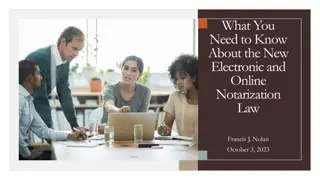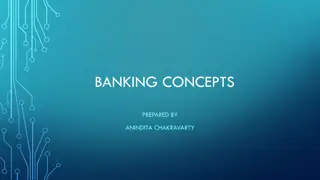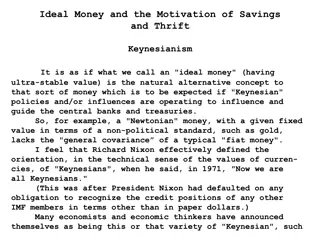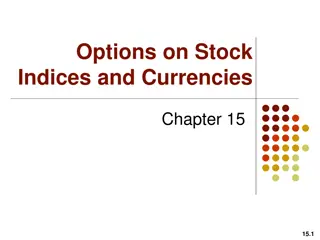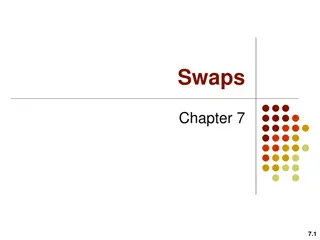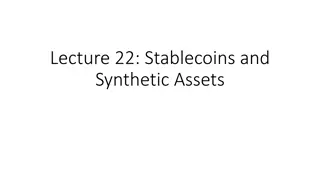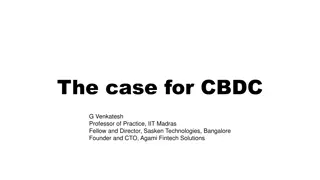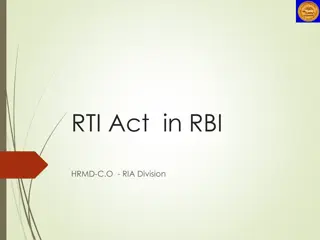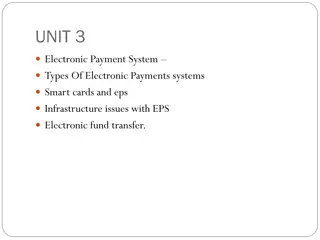Understanding Currency Evolution: From Physical to Electronic
Explore the evolution of currency from physical to electronic forms, covering the history of currency, the role of trust, advantages and disadvantages of physical currency, and insights into electronic currency systems like credit cards and PayPal. Discover how centralized and decentralized systems play a key role in shaping the value and trust in various forms of currency.
Download Presentation

Please find below an Image/Link to download the presentation.
The content on the website is provided AS IS for your information and personal use only. It may not be sold, licensed, or shared on other websites without obtaining consent from the author. Download presentation by click this link. If you encounter any issues during the download, it is possible that the publisher has removed the file from their server.
E N D
Presentation Transcript
CS 3700 Networks and Distributed Systems Bitcoin
Brief History of Currency Towards Decentralized, Online Currency Bitcoin Bitcoin in Practice
What is Currency? Medium of exchange May or may not have intrinsic value (e.g. gold) Value is based on future exchanges Trust is essential Store of value Allows one to store value rather than objects Facilitates lending, debt, investing, and other financial innovations
Physical Currency Ancient coinage was based on precious metals Largely obviated the problem of counterfeiting A fake gold coin is still made of gold Lack of advanced mining techniques limited inflation Paper bearer tokens began to replace coinage around 600 BC Easier to carry, mint large denomination bills Paper was exchangeable for a commodity, e.g. the gold standard Gives the issuing authority flexibility to inflate or deflate the currency Modern physical currency is based on fiat Not linked to a hard commodity, based entirely on trust Why does fiat currency have value ? Social contract everyone accepts the currency, therefor it has value Centralized power the government has the power to enforce taxation, and they accept currency as a means to pay taxes
Physical Currency Advantages Disadvantages Easily portable Cannot double-spend Spend the same piece of paper >1 times Cannot repudiate payment Once you ve given the paper, you can t get it back Semi-anonymous Modulo tracking serial numbers Issuing authority can inflate/deflate as necessary Easy to steal Paper is a bearer token Hard to monitor/tax transactions Again, paper is semi-anonymous Requires trust in the centralized issuing authority Doesn t work online I can t email you a scan of the paper :(
What About Electronic Currency? Credit cards, Paypal, bank e-checks Computers store the amount of money held by each individual/company Transactions move money between parties Why do we trust the electronic money system? Denominated in a physical, fiat currency Rules are enforced by strict regulation and audits E.g. Paypal can t just decide to mint a trillion dollars for themselves Again, trust is centralized in the issuing authority, i.e. the government What is the incentive to participate in the electronic money system? Transaction fees E.g. Visa charges 1.51% of each transaction plus $0.10
Electronic Currency Advantages Disadvantages Works online Easy for issuing authority to monitor/tax/control Strict regulations and auditing Cannot double-spend All transactions are monitored Transactions can be repudiated Credit card chargebacks Requires trust in the issuing authority and third-parties E.g. Visa, Paypal Manual oversight and auditing Issuing authority may prohibit transactions and/or third-parties Took Paypal years to become legitimized High transaction fees No privacy All transactions are monitored
Towards Non-fiat Electronic Currency Goal: e-cash without a centralized issuing authority Store and transfer value without a reliance on commodities or central banks Anyone can join the system and be party to transactions Bitcoin was, arguably, the first viable non-fiat electronic currency Invented by Satoshi Nakamoto in 2009 Released as a whitepaper plus open-source implementation Name is a pseudonym, true author is unknown Built on top of an unstructured P2P system Participants validate transactions and mint currency System works as long as the majority of users (i.e. a quorum) are honest Elegantly solves challenges in computer science and economics
Brief History of Currency Towards Decentralized, Online Currency Bitcoin Bitcoin in Practice
Why is P2P Currency Hard? The most obvious challenge is determining ownership Who owns a given unit of currency? Without strong ownership Forgery a user can mint arbitrary currency Double spending how do you validate and enforce transactions? Theft impossible to separate true and false claims about ownership Rest of lecture: build up design of Bitcoin using strawman proposals Let s call our hypothetical currency neucoin
Requirements and Expectations Requirements Expectations No centralized control Central banks, governments, police No strong identities ID cards, passports Impossible to enforce without centralized control Ideally, we would like anonymity (like physical paper cash) Entirely electronic Not backed by commodities Clear ownership of each neucoin Cannot generate money you don t have Cannot double spend Cannot steal arbitrarily No repudiation
Motivating Example I, Alice, transfer 1 neucoin to Bob. Bob 1 neucoin Alice 1 neucoin I, Alice, transfer 1 neucoin to Charlie. I, Alice, transfer 1 neucoin to Mallory. Mallory 1 neucoin Charlie 1 neucoin Can transactions be forged? Yes Can neucoins be stolen? Yes Can users double spend? Yes
Introducing Cryptography Bob Alice Sa Sb Pa Pb Each entity in neucoin is defined by a public/private keypair Simply referred to as wallets Knowledge of private key gives ownership of neucoins in the associated wallet Coins are transferred from one public key to another public key
Example v2 Signed by Alice s Private Key Pa transfers 1 neucoin to Pb Bob Alice Sa Sb Sa 1 neucoin 1 neucoin Pa transfers 1 neucoin to Pc Pa Pb Sa Sm Sc Charlie Mallory Pa transfers 1 neucoin to Pm Sm 1 neucoin Pm Pc Can transactions be forged? No Can neucoins be stolen? No, assuming the private key isn t stolen Can users double spend? Yes
Serial Numbers How do we prevent users from minting arbitrary neucoins? Add a trusted third-party that issues serial numbers Also known as a bank Let s assume bank is trusted, and has a well known public key 26671 00392 10238 B B B
Example v3 10238 Pa transfers to Pb Bob Alice Sa Sb Sa B 10238 10238 Pa Pb Pa transfers to Pc B 10238 B Sa B Sm Sc Charlie Mallory 10238 Pm Pc B Can transactions be forged? No Can neucoins be stolen? No, assuming the private key isn t stolen Can users double spend? Yes
Preventing Double Spending What if the trusted bank also tracked who owns each neucoin? Bank would have a ledger, serve as official record of ownership Charlie can contact the bank, verify that Alice owns a given coin Problems? Centralized ledger totally defeats the purpose of neucoin Instead, the network is the bank Participants in neucoin collectively keep track of all transactions Known as the public ledger To verify that Alice isn t double spending, Charlie can check the public ledger
Example v4 neucoin Network Is the signature in this transaction valid? Does Pa own 10238? Pa transfers 10238 to Pb Pa transfers 10238 to Pc Alice Sa Sa Sa 10238 Pa Public Ledger Pa owns 10238 Bob Sb 10238 from Pa to Pb 10238 Pb Charlie Sc Pc
Brief History of Currency Towards Decentralized, Online Currency Bitcoin Bitcoin in Practice
Bitcoin at a High-Level Bitcoin is a P2P network of nodes (Bitcoin clients) Each node keeps a log (ledger) of all Bitcoin transactions, ever This log is known as the blockchain Transactions are broadcast to nodes in the P2P network Nodes validate transactions Correct signatures and correct ownership of coins Valid transactions are added to the blockchain and broadcast to other peers Transaction is considered accepted once it appears in the blockchain Ultimate goal: all transactions are known and agreed upon by the network In other words, we want global consensus of ordered events in log Sound familiar?
Challenges 1. How to defend against Sybil attacks? 2. Suppose there is a fork in the blockchain. How do you reconcile? 3. What is the incentive for users to help maintain the blockchain? Bandwidth, CPU, and storage aren t free 4. How much of the network must commit a transaction to their local blockchain for it to be considered accepted? ?/2 + 1 may not be feasible if N is large
Sybil Attack Classic attack that all P2P systems are vulnerable to Mallory can introduce many fake nodes into the network N/2 respond to Bob, N/2 respond to Charlie Implication: one node = one vote doesn t work Mallory s Sybils Pm transfers 10238 to Pb Sm Mallory Sm Pm transfers 10238 to Pc Sm 10238 Pm Bob Sb 10238 Pb Charlie Sc 10238 Pc
Proof-of-Work Need to tie voting to a resource that is hard to obtain In the past, we would have used a commodity (e.g. gold) Identity (e.g. passports) would work, but defeats the purpose Key idea: tie voting to control of computational resources To add a transaction to the ledger, you must present a proof-of-work Proof-of-work can be generated by solving a cryptopuzzle Why is this a good idea? Cryptopuzzles prove that a node expended significant effort Obviates the need for Sybil prevention E.g. one machine pretending to be 100 Sybils doesn t magically get 100x CPU power
Cryptopuzzles Cryptographic hash functions, e.g. MD5, SHA-1, etc. Deterministic, high entropy, and collision resistant Locating A such that hash(A) = hash(A ) takes a long time Example: 221 tries for MD5 A hash function is cryptographically secure iff it is hard to find a pre-image (i.e. a collision) given a hash value H Implement cryptopuzzles in neucoin as follows: Find V such that Hash(V + [array of financial transactions]) < target Nodes in the network have no choice but to brute force V Difficulty can be adjusted by making target larger or smaller
Proof-of-work in Bitcoin Key idea: a node can only add an entry to the blockchain if it solves a cryptopuzzle Other nodes can easily validate new blocks to ensure the puzzle has been solved Changes one node/one vote to one CPU/one vote To dominate the network, Mallory must control significant CPU resources Implementing proof-of-work in Bitcoin Nodes receive transactions, group them into blocks Nodes attempt to solve a cryptopuzzle based on the previous block and the new block Blocks are linked, hence the name blockchain
Mining Blocks Block Hash Prev. Block Hash Nonce X Block Hash Prev. Block Hash Nonce Block Hash Prev. Block Hash Nonce Y Transaction I Transaction F Transaction L Transaction J Transaction G Transaction M Transaction K Transaction H Transaction N Block hash = Hash(Prev Block Hash | Nonce X | <Transactions>) Concatenate all the fields in green Nonce X is the number chosen to make the block hash < target Changing the nonce changes the output of the hash function unpredictably All nodes are competing to identify a nonce that solves the puzzle Creation of new blocks is known as mining
Building the Blockchain At any given time, all nodes are searching for the next block Searching == trying different nonces to solve the puzzle Hoping to get lucky, identify nonce X such that block hash < target Hashing power of the network grows over time More peers join the network, CPUs get faster Bitcoin automatically adjusts target over time Attempts to maintain 1 block/10 minutes on average Once a node discovers a block, it broadcasts it to other peers Other nodes validate (easy, simply recompute the hash) Nodes begin working on the next block (with the new block as Prev)
Forking the Blockchain What happens if two nodes find different blocks simultaneously? Let s call them Dave and Edgar Both Dave and Edgar broadcast Some fraction of the network will start working on Dave s fork, others on Edgar s This is bad. Who is right? Dave and Edgar s blocks may contain different transactions In Bitcoin, nodes always accept the longest chain The longest chain represents the most work Eventually, either Dave or Edgar s fork will find the next block first When this is broadcast, all nodes will switch to the longer chain
Forking Example In case of a fork, network searches for next block in both chains First chain to be lengthened wins , all nodes eventually switch Blocks in loser fork are ignored, transactions go back in the queue
Challenges, Revisited 1. How to defend against Sybil attacks? Require nodes to solve cryptopuzzles to commit transactions to the blockchain 2. Suppose there is a fork in the blockchain. How do you reconcile? Longest chain of blocks wins 3. What is the incentive for users to help maintain the blockchain? 4. How much of the network must confirm a transaction for it to be considered accepted? Only one node needs to solve the cryptopuzzle to create a new block However, a single block may not be good enough for confirmation Suppose that one block is part of a fork it may get replaced in the future More on this later
Creation of New Coins What is the incentive for users to act as Bitcoin nodes? Computing hashes is CPU intensive Bandwidth of communication with peers and users Storage cost of storing the entire blockchain Bitcoin solves the incentive problem in two ways Transactions may include a transaction fee Paid to whoever wins first, i.e. mines a block that includes the transaction New blocks mint new coins Node who wins mines a fixed amount of coins as a prize This is why it s called mining Current reward is 12 BTC (worth around $9000!) Called a coinbase transaction
Coinbase Transactions Block Hash Prev. Block Hash Nonce X Transaction I Transaction J Coinbase Transaction K Elegantly solves several problems How are bitcoins minted? Who gets newly minted coins? Reward for mining halves every 210,000 blocks Currently 12 BTC, was 50 BTC until 2012, 25 until 2016 Will become 0 in year 2140; 21 million total bitcoins At this point, only transaction fees will incentivize miners
Do We Need Serial Numbers? Final annoyance: where do bitcoin serial numbers come from? Trick question bitcoins don t have serial numbers Idea: bitcoins don t matter, only transactions matter All transactions have IDs, simply the hash of their fields To transfer bitcoins Simply state the transaction ID where you received the coins Easy to verify that the transaction exists, as well as coin ownership (via the signature) What if you don t want to move all coins from a previous transaction? Bitcoin transactions may have multiple inputs and outputs Pay the change back to yourself ;)
Real Bitcoin Transactions Transactions have multiple inputs and outputs Each input is the ID of a previous transaction All value must be included Nodes verify that no other transactions refer to the input IDs Each output is an amount and a public key Signed by owners private key Implicit output: sum(input) sum(output) If it exists, can be claimed by the miner as the transaction fee
Example Transactions Tx 1234, coinbase: Pa -> 25 BTC Alice Sa 25 BTC 24 BTC 22 BTC 21 BTC Tx 2578: input {1234}, output {Pa -> 24 BTC, Pb -> 1 BTC} Pa Bob Sb Tx 3002: input {2578}, output {Pa -> 22 BTC, Pb -> 1 BTC, Pc -> 1 BTC} 1 BTC 2 BTC 1 BTC Pb 0.01 BTC left over as a transaction fee Tx 3587: input {3002}, output {Pa -> 21 BTC, Pc -> 0.99 BTC} Charlie Sc 1.99 BTC 2.99 BTC 1 BTC Tx 4013: input {2578, 3002}, output {Pb -> 1 BTC, Pc -> 1 BTC} Pc
Is Bitcoin Secure? Can I fake a transaction? (i.e. steal your bitcoins) No, you would need access to the victim s private key Can I edit the blockchain? (i.e. remove or modify old transactions) No, all blocks are linked by their hashes Changing historical block Btwould require changing all blocks [Bt , Bcurrent] Can I repudiate a transaction? (i.e. deny that I paid you) No, all of your transactions are signed by your private key Plus, you can t go back and change previous blocks Can I mint money out of thin air? Yes, but only through legitimately solving a cryptopuzzle (i.e. a coinbase txn) All peers can validate that your block (and the minted coins) are correct
What About Double Spending? Can I double spend? Sort of you could publish two new transactions with the same inputs But, the network will only accept one of them eventually However, there may be a period of time where both new transactions are committed If the blockchain forks, both transactions may exist concurrently When should a recipient conclude that a transaction is truly accepted? Wait for C confirmations, i.e. blocks after the transaction in question The longer the chain, the less likely it will be replaced by a fork If a vendor requires 6 confirmations and an attacker controls 10% of the networks hashing power, the attack will succeed 0.02428% of the time
CPU Monopoly What if I control 51% of the networks hashing power? All bets are off, no longer a decentralized currency Attacker can control all future blocks Monopolize creation of new coins Double spend Deny arbitrary transactions In reality, 25% of total hashing power is enough Recent research on selfish mining attacks Network needs to be diverse to prevent this kind of attack
Incentives, Revisited Why do nodes accept transactions? Coinbase transactions and transaction fees Essentially, monetary rewards Why do nodes accept a new block? Couldn t they just ignore it and keep mining the old one? No incentive: mining is guessing, so it s not like you are close Also, all other nodes will switch to new block To succeed, you now need to mine two blocks in a row
What About Anonymity? Are bitcoin transactions truly anonymous? No, transactions are pseudonymous Everyone is identified by their public key(s) The blockchain (all transactions ever) is public Current owner of any coin can be determined The provenance of any bitcoin can be ascertained (past ownership) Related question: are bitcoins fungible? Fungible mutually interchangeable Physical dollars are fungible, one is just as good as another Since the provenance of bitcoins can be tracked, they may not be fungible E.g. if coin X is stolen, user may refuse to accept X in future transactions in retaliation
Brief History of Currency Towards Decentralized, Online Currency Bitcoin Bitcoin in Practice
BTC to USD exchange rate has been very volatile over time All-time high: $17,133 Current: $5200 Several bitcoin millionaires exist Mined a bunch of coins back in 2009 One guy threw away a machine with a private key linked to >$500k in coins :(
Bitcoin Wallets Two options Desktop client: You participate as node in the network Direct access to peers and the blockchain, but no mining Private key on your machine (lose it, lose your coins) Online Service: You give your private key to a company/site Log in to site to view balance , make transactions; easy to use They have your key Electrum What s up with stolen bitcoins? Typically from Wallet sites Hackers break in, get private keys, transfer bitcoins to themselves
Anonymity Recall that bitcoin is pseudonymous What if you want stronger anonymity? Best practice: generate a new wallet for every transaction Users can have many wallet addresses (i.e. keypairs) Makes linkability somewhat more difficult Even more anonymity: use a mixing service to launder your coins Service uses a well known wallet address Accepts bitcoins from any source Return the coins after some time (minus a small fee) Assuming volume is high, provides unlinkability of inputs and outputs
Mining In theory, anyone can download bitcoin and start mining Your node will search for blocks But in practice, you will never win Arms race: CPU < GPU < FPGA < ASICs Real miners use thousands of chips custom designed to solve cryptopuzzles Much faster and more power efficient than general purpose hardware Many miners operate in Iceland (cheap power and free cooling)
Mining Pools Problem: Bitcoin is a lottery You are extremely unlikely to win Can we make it more fair ? Nodes get out what they put in ? Solution: mining pools Groups of nodes that work together Split proceeds when any node finds the next block (more fair) Lots of mining pools today Instances of pools with >25% of total hash power have existed
Proof-of-Work in Mining Pools How to evenly distribute coins in a mining pool? How to determine what nodes put in ? Nodes could lie, say I worked really hard! Elegant solution: Nodes report best hash they found for block i.e., they say I didn t win, but here s the best I did Corresponds to amount of effort expended Payout distribution then based on how hard best hash was Closer to target, more coins
Civil War Bitcoin functions because of its community Now that bitcoin is popular, the community is large To make changes, everyone must agree and adopt new software Blocksize and transactions The max block size is 1 MB, and block rate is 1 every 10 minutes This effectively caps the max capacity and speed of the bitcoin network To compete with Visa, bitcoin needs to handle more transactions at lower latencies How to solve these scalability challenges? Hard forks Bitcoin Cash gradually increases the blocksize over time Sidechains push tiny transactions out of the main blockchain Do nothing let transaction fees rise for people seeking high-priority transactions
Altcoins P2P + cryptopuzzles + blockchain + incentives is a general formula Can be applied to other distributed systems problems besides currency Bitcoin is open-source Led to the creation of dozens of alternate coins Litecoin faster mining rate and scrypt instead of SHA-256 (harder to design ASICS) NXT designed for securities trading Filecoin designed for storing files in the blockchain Namecoin designed as a replacement for DNS Etherium distributed virtual machine + smart contracts Dogecoin litecoin + shiba inus
